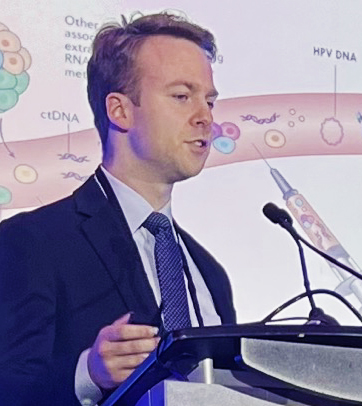


By Michelle Mierzwa, MD, University of Michigan
As the incidence of human papillomavirus-positive (HPV+) oropharyngeal cancer (OPC) has increased rapidly in North America, improved screening and early detection has been a significant focus of research. There is currently no proven standard screening procedure for HPV-related oropharyngeal cancer. HPV serology has been proposed as a sensitive, scalable, and cost-effective early detection test, but patients may be seropositive years before their clinical presentation and the benefit of enhanced clinical screening for seropositive patients is under investigation. HPV ctDNA may enhance our ability to detect invasive cancer in seropositive patients, but this concept is not well understood to date. Moreover, the concordance of baseline HPV serology and HPV ctDNA and their respective associations with cancer burden in OPC patients are not known.
In this study from Princess Margaret Cancer Centre, presented by Lucas Penny, PhD, during yesterday’s Plenary, peripheral blood plasma collected from 100 patients prior to treatment with definitive radiotherapy was analyzed for both HPV serology as well as plasma HPV ctDNA using a custom HPV-targeted capture panel for 38 HPV genotypes (HPV-seq). These metrics were then compared to tumor burden quantified on radiotherapy simulation CT scans as total gross tumor volume (GTV) as well as T- and N-categories. For both HPV serology and HPV ctDNA, 100% of cases were found to be positive, and HPV16 was the most prevalent genotype (98% for each). Among the 98 patients with detectable HPV16 within ctDNA, HPV16 E6 seropositivity demonstrated high sensitivity to detect cancer (95%), compared to other antibodies including E1, E4, E7 and L1. Levels of HPV ctDNA but not HPV16 E6 antibodies were positively associated with disease burden as determined by T-category (p=0.098), N-category (p=0.050) and GTV (p=1.0e-06).
This is the first report to compare HPV serology and HPV ctDNA sequencing in OPC patient plasma. Both tests were highly sensitive and could identify multiple oncogenic HPV genotypes. An important distinction between HPV ctDNA and HPV serology as reported in this study was the positive association of HPV ctDNA levels, but not HPV antibody levels, with tumor burden. This result suggests that the two tests could play complementary roles in an early detection program, with HPV serology indicating risk of developing OPC and HPV ctDNA providing a quantitative assessment of cancer progression.
“We are interested in applying breakthroughs in HPV ctDNA detection to the problem of early detection of OPC, where delayed diagnosis can result in worse outcomes and debilitating side effects,” said senior author Scott Bratman, MD, PhD, Associate Professor at University of Toronto and Clinician Scientist at Princess Margaret Cancer Centre. "More studies are needed to evaluate the potential utility of combining sensitive and cost-effective HPV serology with comprehensive HPV ctDNA testing.”
Earlier publications surrounding HPV ctDNA comparison initially did not show significant correlations between ctDNA counts and tumor burden. However, the development of newer assays with increased sensitivity shows increased promise for early cancer detection and quantification. The present study utilizes a newer approach that can detect an increased array of high-risk HPV genotypes, as well as additional regions of each HPV genome, thereby boosting sensitivity. Future exciting directions may include the ability to detect microscopic invasive disease prior to clinical presentation, to detect preclinical metastatic disease at presentation to further personalize therapy, and to detect microscopic residual disease immediately post-treatment for patients that may benefit from further therapy. Clinical studies such as the VOYAGER, PHORCAST and TRINITY early detection studies are ongoing to incorporate these new technologies into enhanced clinical screening for patients at high risk to develop HPV related oropharynx cancer.
Abstract 5 - HPV Serology and Circulating Viral DNA for Detection, Genotyping, and Risk-Stratification in p16+ Oropharyngeal Cancer was presented during the K. Kian Ang, MD, PhD, FASTRO, Commemorative Plenary Session at the 2024 Multidisciplinary Head and Neck Cancers Symposium on February 29, 2024.